Shannon Lectures – 2017
Shannon Lectures, 2017
Expo Exposed!
Convenor: Professor Paul Litt
About the series:
The History Department’s Shannon Lecture Series for 2017, will commence on September 22, 2017 with more details to be posted as they become available. This year’s lecture series looks at Expo 67 as the highlight of Canada’s centennial. A world’s fair held in Montreal, it dazzled the world with its daring architecture, innovative exhibits, and high-minded theme, “Man and His World.” Many Canadians regarded it as Canada’s coming-out party, a moment when the young nation burst into the international limelight and strutted its stuff to universal acclaim. Substitute “Quebec” or “Indigenous Peoples” for “Canada” in the previous sentence and it would be equally true – Expo 67 was a rich, multivalent spectacle that generated diverse messages. In Canada’s 150th anniversary year, the Carleton Department of History is revisiting Expo 67 to reflect upon the meaning of it all. A select group of lecturers will address key topics such as Expo’s intellectual origins, how it became a proud emblem of modernization for both Canadian and Quebec nationalists, its impact on Indigenous rights and culture, and its iconic stature in the histories of architecture and cinema. X out the dates in your calendar to experience exposition by Expo experts that will expand your mind exponentially.
This public lecture series is made possible by the Shannon Fund, an endowment created by an anonymous friend of the Department of History.
All lectures will take place in the Multi-Media Lab (room 482), Discovery Centre, MacOdrum Library starting at 2:30PM followed by a reception in the History Lounge (433 Paterson Hall).
Friday, September 22, 2017
“A Painted Summer Scene: Expo 67 in the Context of Canada in the 1960s”
Dr. Gary Miedema (Project Manager, City of Toronto)
Multi-Media Lab (room 482), Discovery Centre, MacOdrum Library starting at 2:30PM followed by a reception in the History Lounge (433 Paterson Hall).
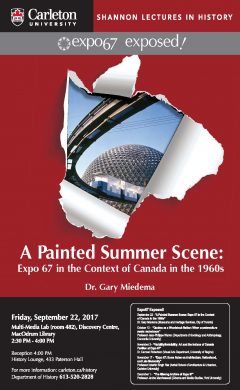
Abstract
Expo 67 was an astounding project that captivated citizens of Canada and the world. Fifty years later, it continues to resonate with those who experienced it, and – as a wealth of studies and exhibits demonstrate – with scholars and curators of Canada’s past.
Still a powerful moment in Canada’s national narrative, Expo 67 comes into focus when placed in the context of Canada’s Centennial celebrations. Together, Expo 67 and the Centennial reflected a particular response to the dramatic political and cultural changes – and challenges – faced by Canada and the world in the 1950s and 1960s. At Expo 67, that response was crystallized in its theme, Man and His World. Dedicated to profiling the universality of the human experience, Expo 67 emphasized the interconnectedness and interdependence of humanity as the key to a bright future. It was a message that fit perfectly into the Centennial Celebrations, where planners also strove to emphasize that what Canadians shared together was more important than that which held them apart. Both messages were demonstrated best, perhaps, in the approach of both the Centennial Celebrations and Expo 67 to the historically divisive issue of religious expression – including the intense negotiations over the presence of religious pavilions on the Expo isles.
About Dr. Gary Miedema

Dr. Gary Miedema is the author of For Canada’s Sake: Public religion, Centennial Celebrations, and the Re-making of Canada in the 1960s, published by McGill-Queen’s University Press in 2005. For over 10 years he was the Chief Historian of Heritage Toronto, an agency of the City of Toronto, where he continued to study Canada’s mid-twentieth century decades. He is now a Project Manager with the Museums and Heritage Services section of the City of Toronto, and has been directly involved in the planning of Canada 150 programming in that city.
Friday, October 13, 2017
“Quebec as a Woodstock Nation: When counterculture meets mainstream”
Professor Jean-Philippe Warren (Department of Sociology and Anthropology, Concordia University)
Multi-Media Lab (room 482), Discovery Centre, MacOdrum Library starting at 2:30PM followed by a reception in the History Lounge (433 Paterson Hall).
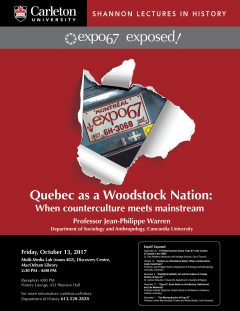
Abstract
Expo 67 was part of the global wave of change that affected all Western societies in the 1960s. The decade saw the democratization of higher education, the rise of the consumer society, and the consolidation of the middle class. These profound changes had specific repercussions depending on the national context. How did the decade affect Quebec? What were the province’s principal adaptations, interpretations and translations of the sixties? From to the creation of cegeps to l’Osstidcho and the foundation of the Parti québécois, 1960s Quebec was a nation literarily transformed from within. In less than ten years, a ‘priest ridden province’ had become, in the words of Marshall McLuhan, a ‘hippie nation.” Expo 67 both reflected and stimulated the contemporary transformation of Quebec.
About Professor Jean-Philippe Warren

Professor Warren is a professor of sociology at Concordia University in Montreal, and he holds degrees from Université Laval, the University of Montreal and the Ecole Normale Supérieure, in Paris. He has published over 150 articles in intellectual and scholarly journals and has published on a wide range of subjects related to the history of Quebec – including indigenous peoples, social movements, popular culture, youth, the Catholic Church And the arts. His works have appeared in journals of sociology, history, studies of religions, literature and anthropology. His book L’Engagement sociologique (Boréal) received the Clio Award and the Michel Brunet Award in 2003. He is also the author of several books, notably Discours et pratiques de la contreculture au Québec (Sptentrion, 2015), with Andrée Fortin, and Autour de Paul-Émile Borduas (Boréal, 2011).
Friday, November 3, 2017
“Visibility/Invisibility: Art and the Indians of Canada Pavilion at Expo 67”
Dr. Carmen Robertson (Visual Arts Department, University of Regina)
Co-sponsored by the School of Indigenous and Canadian Studies
Multi-Media Lab (room 482), Discovery Centre, MacOdrum Library starting at 2:30PM followed by a reception in the History Lounge (433 Paterson Hall).
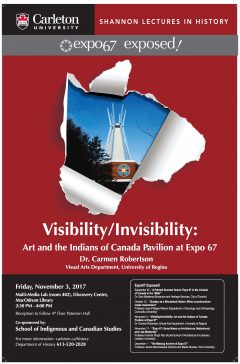
Abstract
Carmen Robertson proposes to trouble notions of visibility and invisibility in relation to the planning, execution, and the archiving of contemporary Indigenous art for the Indians of Canada Pavilion at Expo ‘67. Included under the auspices of the Department of Indian Affairs and Northern Development (DIAND), today the Pavilion is mostly viewed as a significant moment in the history of contemporary Indigenous arts, yet its history remains fraught with issues of censorship and colonial politics that have continued to plague the arts.
After an analysis of the art commissioned by artists from across Canada for the pavilion including works by Norval Morrisseau and Alex Janvier, the lecture will culminate with a conversation between Robertson and John Moses, a member of the Six Nations Delaware band and Carleton doctoral candidate, about the legacy of the Indians of Canada Pavilion.
About Dr. Carmen Robertson
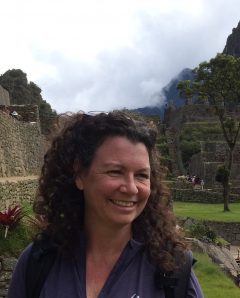
Dr. Carmen Robertson is professor of art history at University of Regina in the MAP Faculty. An Indigenous scholar of Scots Lakota ancestry from Saskatchewan, her research centers on contemporary Indigenous arts and constructions of Indigeneity in popular culture. In 2016 she published Norval Morrisseau: Life and Art with Art Canada Institute (Toronto, 2016) and Mythologizing Norval Morrisseau: Art and the Colonial Narrative in the Canadian Media (University of Manitoba Press, 2016). In addition to essays in edited collections and such scholarly journals as American Indian Quarterly, Canadian Journal of Art History, Media History, RACAR and Third Text, Robertson also co-wrote with Mark C. Anderson the award-winning Seeing Red: A History of Natives in Canada’s Newspapers (University of Manitoba Press, 2011). An independent curator, she is curating an exhibition of new work by Dana Claxton at the MacKenzie Art Gallery for fall 2017.
Friday, November 17, 2017
“Expo 67: Some Notes on Architecture, Nationhood, and Late Modernity”
Professor Inderbir Singh Riar (Azrieli School of Architecture & Urbanism, Carleton University)
Co-sponsored by the Azrieli School of Architecture and Urbanism
Multi-Media Lab (room 482), Discovery Centre, MacOdrum Library starting at 2:30PM followed by a reception in the History Lounge (433 Paterson Hall).
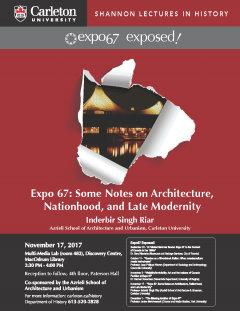
Abstract
Expo 67 produced both continuations of and crises in the emancipatory project of modernism. Like universal exhibitions before it, Expo 67 stood to mediate relations between aesthetics and technics, between peoples and things, through its most visionary architecture. Resulting theories of design, especially attempts to derive enormous structures from complex geometries, carried a modernist conviction of long duration: namely, an abiding technological determinism shaping dreams of a new global citizen. At the very same moment, this universalism was fraught with ambiguity: to embrace techno-science inevitably meant facing the aftershock of global war and the present terror of nuclear holocaust. The tension animated attempts at advancing a novel “cellular architecture”, which the Expo 67 authorities would promote as the lasting contribution of the fair. Confronting the functionalist inheritance of the Modern Movement, architects embraced bio-mechanical metaphors and models to discover primal forms capable of engendering “open” concepts of society and space. Such ideas and ideals informed efforts like the breathtaking Man the Producer theme pavilion – a key subject of this lecture – with its remarkable tetrahedra epitomising the optimism of large-scale thinking in the 1960s. To pioneering Montreal architects responsible for the Expo 67 theme Man and His World (a paean to contemporary humanism inspired by UNESCO and the celebrated Family of Man photography exhibition, among other sources), these works (deliberately situated alongside heroic examples recuperated from the nineteenth century) meant rejecting the most enduring symbols of world exhibitions: the nation-state and its symbolic architecture. Theirs was a vision of late modernity, a moment, not fully marked by mass culture and media, during which nationalisms could still be channelled, via architecture, into alternative kinds of political belonging free of narrow self-interest, conflict, and inequity. The utopian hope would be fleeting, promised, after all, in a short-lived spectacle unfolding across temporary fairgrounds removed from any difficulties of the city, politics, and history.
About Professor Inderbir Singh Riar
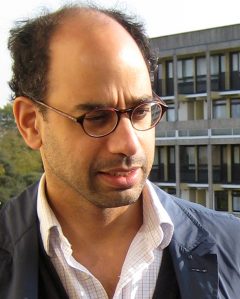
Inderbir Singh Riar is an architectural historian. He explores ways in which architects have imagined the modern metropolis as producing ideal citizenries. This work has taken several forms including an extensive look at Toulouse-Le Mirail, the consequential French ville nouvelle built in the 1960s (a study undertaken in collaboration with the Paris-based photographer Mark Lyon and supported by the Graham Foundation for Advanced Studies in the Fine Arts). Recent research examines ideologies of “reconstruction” in West Germany and how cities were seen as sites of democratic sentiment in the aftermath of war, occupation, and fascism. A larger interest in postwar architecture culture informs Riar’s current book project on the intellectual program and experimental architecture of Expo 67 (McGill-Queen’s University Press, 2019). Along with his scholarly activity, Riar serves on the Board of Directors of the Diefenbunker, Canada’s Cold War Museum in Carp, Ontario.
Friday, December 1, 2017
“The Missing Archive of Expo 67”
Professor Janine Marchessault (Cinema and Media Studies, York University)
Co-sponsored by the School for Studies in Art and Culture
Multi-Media Lab (room 482), Discovery Centre, MacOdrum Library starting at 2:30PM followed by a reception in the History Lounge (433 Paterson Hall).
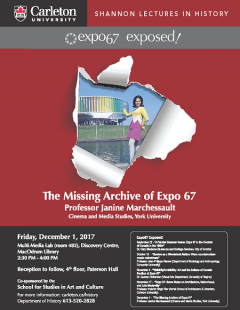
Abstract
Expo 67 was a spectacular showcase of avant garde audio-visual technology and multi-screen film. One might expect that its cinematic legacy would have been lovingly preserved for posterity. Instead, only some of its films have been properly archived. Many more were misplaced and forgotten, and while some have recently been recovered, others seem to have been lost forever.
This lecture explores the possibility that the Expo zeitgeist was at odds with the archival impulse. Immediacy and simultaneity defined Expo’s mediatic displays, creating an ever-unfolding total environment infused with what has been described as the ‘enduring ephemeral’ (Chun, 2008). Does an event with an ahistorical sensibility somehow pre-empt preservation for posterity?
Recent anarchival artistic projects and films about the utopian Expo moment play on this possibility. Space Fiction & the Archives (film and installation Jacqueline Hoang Nguyen 2012) and By the Time we got to Expo (Philip Hoffman/Eva Kolcze 2015) are works of dynamic excavation that undermine any attempt to stabilize public memory of Expo 67.
About Janine Marchessault

Janine Marchessault is a Professor of Cinema and Media at York University. She is a founder of the Future Cinema Lab, and the 2014-2016 inaugural Director of Sensorium: Centre for Digital Arts Research at York. In 2012, she was awarded a prestigious Trudeau Fellowship to pursue her curatorial and public art research. She is the author of Ecstatic Worlds: Media, Utopias and Ecologies (MIT 2017); Cosmic Media: Marshall McLuhan (Sage 2005); and (co)editor of numerous collections including 3D Cinema and Beyond (Intellect/ University of Chicago Press 2013); Reimagining Cinema: Film at Expo 67 (MQUP 2014) and Cartographies of Place: Navigating the Urban (MQUP 2014). A past President of the Film Studies Association of Canada, she has held faculty positions at McGill University, Ryerson University and has taught at the Escuela Internacional de Cine y TV. Books in preparation include Archival Imaginary: Creative Approaches to Digital Memory; The Oxford Guide to Canadian Cinema; and Process Cinema: HandMade Film in the Digital Age.
Please contact Paul Litt at paul.litt@carleton.ca ideally at least two weeks in advance of this event, and at the very least one week in advance, should you wish to request interpretation services.

